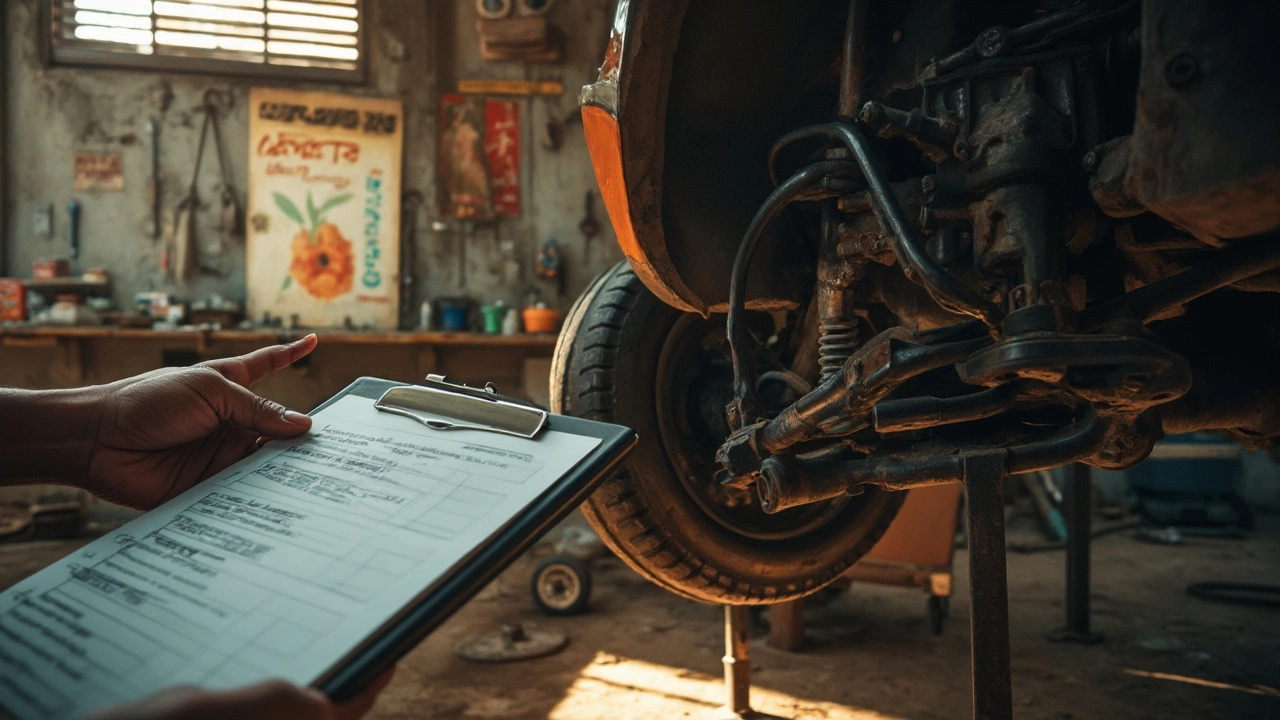Ever had that moment when you drive over a pothole and your whole car feels like it’s about to fall apart? Or maybe you’re noticing your steering is off, and every bump on the road sends a shiver up your spine. Trust me, nothing kills the joy of a smooth ride faster than a dodgy front suspension. Sometimes it sneaks up quietly, other times it makes so much noise even my curious cat Loki would leap off the hood in alarm. Ready to figure out if your car’s front suspension is begging for retirement?
Common Warning Signs Your Front Suspension Is Failing
If you’re like most drivers, you may not think about your front suspension until something feels off. But those important parts upfront—shocks, struts, springs, and control arms—work non-stop to keep things smooth. When they start to wear, your car will tell you, if you’re paying attention.
- Noisy Ride: If you hear clunking, creaking, or metallic sounds when driving over bumps, turning, or braking, consider it a red flag. Most of the time, these sounds point to worn bushings, ball joints, or mounts. One customer told me his Honda started making a noise every time he turned into his driveway—two weeks later, his mechanic found a cracked strut mount.
- Poor Handling: Does your steering feel sluggish or loose? Maybe the car “drifts” during turns or sways after sharp maneuvers. Worn suspension can’t keep the tires glued to the road. That’s dangerous, especially at higher speeds. In a 2023 AAA study, vehicles with bad suspension took up to 15% longer to stop from 60 mph compared to those with a healthy setup.
- Visible Sagging or Uneven Height: If your car’s nose looks lower than usual, or one side is sagging, that’s a visual cue the springs or struts are shot. A friend of mine had his sedan parked next to mine, and I noticed his front right wheel practically swallowed by the fender. One spring had snapped clean in two.
- Bouncy Ride: Try the bounce test. Push down firmly on the hood and let go. If the car bounces more than twice before settling, your shocks or struts aren’t doing their job. This age-old trick works almost every time and costs nothing.
- Tire Wear Patterns: Worn or uneven tread on your front tires? A misaligned or struggling suspension is often to blame, not just bad wheel alignment. Watch for cupping (scalloped dips) as a giveaway.
- Fluid Leaks: See an oily residue around your shock absorbers or struts? They could be leaking hydraulic fluid—another sign replacement is needed. Most shocks should stay bone dry over years of normal use.
Missing these symptoms can make things worse. Not only does it wear down your tires faster, but it can also mess up steering and brake systems. Bottom line, your car might still drive with a bad suspension, but you’re risking your safety and your wallet. Once, a guy ignored his Jeep’s gnarly front-end noise for months. His repair bill ballooned because worn-out shocks wrecked other components—turns out ignoring the signs doesn’t make the problem disappear.
How a Healthy Front Suspension Should Feel
Getting behind the wheel of a car with good suspension feels like gliding. You barely register most bumps, the steering reacts quick and precise, and cornering feels confident—even on winding roads. If you remember your car feeling snappier, quieter, or easier to drive not long ago, that memory is a hint your suspension has dulled with time.
- The steering wheel doesn’t wobble or vibrate, even at highway speeds.
- The car tracks straight—you don’t need to fight to keep it in a lane.
- You can brake hard without the front end dipping nose-first into the pavement, and your stopping distance feels short and controlled.
- Tires wear evenly—no suspicious balding or scalloping near the edges.
- There’s little to no body roll when taking tighter corners.
Compare that to a car with failing front suspension, and it’s like night and day. You might get used to a rougher, noisier ride—some people blame old age or “just the way the car is”—but if you swap for a new suspension, it’s almost shocking how much smoother everything gets again. Car reviewers regularly mention how a fresh or upgraded suspension feels transformative; even a 10-year-old sedan can feel young again on new struts and shocks.
Of course, the way you drive and where you live matter a lot. If your roads are loaded with potholes or speed bumps, suspension parts wear out way faster. In places with harsh winters or rough city streets, some drivers replace shocks and struts every five years or 60,000 miles. Meanwhile, those rolling around small towns with gentle, well-paved streets can get 80,000 miles or more before problems appear.
If you’re unsure whether your ride feels “normal,” hop in a friend’s car of similar age and compare. Nothing like a back-to-back test to show you what you’ve been missing—or putting up with for too long.

DIY Checks: Simple Ways to Inspect Your Suspension
You don’t have to be a mechanic to size up your own front suspension. While the real diagnostics need a careful look under the car, there are a few checks anyone can do at home before booking that service appointment.
- Bounce Test: As mentioned earlier, just press down hard on the hood and release. If the car shakes more than twice, your shocks are tired out. It’s a fast gut check anyone can try in a driveway.
- Look and Listen: Crawl around and peek at your front tires. Find uneven tread wear, low spots, or funny patterns? That’s often a sign the suspension isn’t keeping the wheels planted evenly.
- Visual Inspection: Grab a flashlight and check under the wheel wells for cracked rubber boots, leaking fluid, or corroded springs. Rust flakes on the spring can mean deep trouble—eventually, those springs can snap, especially in older or chilly climates.
- Steering Feel: With the car parked (engine running, foot on brake), turn the wheel left and right gently. Any clunks, pops, or resistance can mean ball joint or tie rod problems—both are part of the front suspension party.
- Shock Absorber Sound Test: Drive down a known rough patch at 20–30 mph with the radio off and windows cracked. Listen for a hollow or banging sound as you hit bumps. Compare both sides; the bad one is usually louder.
Not sure what’s normal? Loki, my cat, once sniffed under my brother’s truck after he heard a metallic tapping noise. Turns out, he had a sway bar link held on by a thread. You never know what you’ll find by following your ears—and sometimes your pets.
Honestly, most modern cars have pretty tough suspensions. But when they do go bad, symptoms aren’t always huge or dramatic right away. Early checks can help you avoid big trouble down the road.
What Causes Front Suspension Parts to Wear Out?
If you’re thinking, “Why does my front suspension even need replacing?” you’re not alone. These parts take an incredible beating every day. Here’s what can take them down:
- Rough Roads: Every pothole, speed bump, or curb you hit sends a shockwave through your front suspension. Over time, all that jouncing wears out the soft bushings and rubber, then the metal components start to go.
- Weather: Road salt, rain, and snow cause rust, especially on springs and mounts. If you see flakes or chunks coming off, that’s steel getting weaker.
- Heavy Loads: Carrying lots of passengers or cargo puts strain on the springs and shocks, wearing them out quicker than normal.
- Age: Nothing lasts forever. Even if you baby your car, rubber dries out and cracks, oil leaks out, and parts just tire out over time
- Low Quality Replacement Parts: Cheap aftermarket struts and shocks wear out faster than good OEM or high-quality brands. You’ll pay less upfront, sure, but could be swapping them again in just a couple of years.
Check out this table for a quick look at how long some front suspension parts usually last, based on normal driving conditions:
| Suspension Part | Average Lifespan (Miles) | Common Failure Clues |
|---|---|---|
| Shocks/Struts | 50,000 - 80,000 | Bouncing, fluid leaks, clunking |
| Springs | 100,000+ | Sagging, uneven ride height, snapping sound |
| Control Arms/Bushings | 60,000 - 100,000 | Vibration, knocking over bumps, wandering steering |
| Ball Joints | 70,000 - 150,000 | Clunking noise, loose steering, uneven tire wear |
Remember, these numbers shift depending on your roads, how you drive, and the type of car. Too many speed bumps on your daily route? Expect those numbers to drop.

Repair vs. Replace: When To Swap Out Your Front Suspension
This is the big question: Is it time to open your wallet or can you wait a bit longer? Waiting too long can mean more money in the long run, but jumping the gun is no fun either.
- Simple Repairs: Some minor issues get fixed fast—a new bushing, shock mount, or tie rod end. These are cheap and quick if caught early.
- Full Replacement: If you’re hearing multiple noises, feeling lots of bouncing, or seeing visible leaks and sagging, go for a full replacement. Modern strut assemblies often come pre-loaded with new springs and mounts, which saves time on labor.
- DIY vs. Shop: If you’ve got a basic garage, you can sometimes swap shocks or springs yourself, especially on older cars without fancy electronics. Just double-check all bolts, and always re-align your wheels afterward. Many DIYers on forums report saving hundreds by doing the labor themselves but warn you need the right tools and patience.
- Don’t Mix Old and New: Replacing just one side up front is a bad move. Always do both, or you’ll have uneven ride and handling—a recipe for weird tire wear and even more problems later.
Ever wondered how much this will set you back? Numbers vary, but here’s a ballpark:
| Service | Typical Cost (USD) |
|---|---|
| Front Shock/Strut Replacement (both sides, parts & labor) | $350 - $900 |
| Control Arm/Ball Joint Replacement (one side) | $250 - $600 |
| Full Front Suspension Overhaul | $1,200 - $2,500 |
Paying more for quality parts usually means fewer future headaches. And don’t skip the alignment; new suspension with crooked wheels is like buying new shoes and wearing them on the wrong feet.
Fun fact: NHTSA crash data shows cars with faulty suspension systems have up to a 20% higher risk of losing control during emergency maneuvers. This isn’t something you want to leave for another month.
If your car’s front end is acting up, trust your instincts. Trust your ears (and maybe your cat). The signs will pop up before something major fails, and catching them early means less cost, less risk, and a whole lot more comfort behind the wheel.




